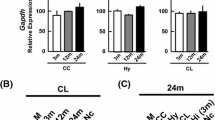Abstract
The effect of neonatal castration on neuron capacity for binding septal dorsal, lateral, and medial nuclei, Brock's diagonal fold nucleus, and terminal streak bed nucleus of radio-labeled sex steroids (3H-testosterone and3H-estradiol) has been studied. Neonatal castration performed on the first day of male postnatal life increased the capacity of brain septal complex neurons for uptake of sex steroids, mainly3H-testosterone. The strategic position of the septal complex in the brain and the presence of neurons actively taking up sex steroids indicated the important role of this structure of the limbic system of the brain in the formation of neural mechanisms in, the regulation of sexual functions in male rats.
Similar content being viewed by others
Literature cited
I. G. Akmaev, Structural Bases of Mechanisms of Hypothalamic Regulation of Endocrine Functions [in Russian], Moscow (1979).
V. N. Babichev, Neuroendocrinology of Sex [in Russian], Moscow (1981).
N. G. Khrushchov, Functional Cytochemistry of Loose Connective Tissue [in Russian], Moscow (1969).
A. P. Arnold, J. Histochem. Cytochem.,29, 207–211 (1981).
G. A. Barraclough and R. A. Gorski, Endocrinology,68, 68–79 (1961).
C. Deborak and Y. Pauline, J. Comp. Neurol.,231, 473–489 (1985).
M. Hines, F. C. Davis, A. Coquelin, et al., J. Neurosci.,5, 40–47 (1985).
B. S. McEwen, Science,211, 1303–1311 (1981).
M. S. Krieger, J. I. Morrel, and D. W. Pfaff, Brain-Endocrine Interaction III: Neural Hormones and Reproduction, Basel (1978), pp. 197–211.
P. J. Sheridan, Clin. Neuropharmacol.,7, 281–295 (1984).
N. M. Sherwood and P. S. Timiras, A Stereotaxis Atlas of the Developing Rat Brain, Los Angeles (1970).
W. E. Stumpf, M. Sar, D. L. Keefer, et al., Neuroendocrine Regulation of Fertility, Basel (1976), pp. 46–55.
W. E. Stumpf and M. Sar, J. Steroid Biochem.,7, 1163–1170 (1976).
H. D. Rees and R. P. Michael, Dev. Brain Res.,13, 73–79 (1984).
H. D. Rees, R. W. Bonsall, and R. P. Michael, Exp. Brain Res.,63, 67–75 (1986).
Author information
Authors and Affiliations
Additional information
The author is extremely grateful to Prof. A. G. Reznikov and Prof. V. B. Rozen for recommending the methods used in this study.
Translated from Problemy Éndokrinologii, Vol. 34, No. 6, pp. 56–59, November–December, 1988.
Rights and permissions
About this article
Cite this article
Myslitskii, V.F. Effect of neonatal castration on capacity of male rat brain septal complex neurons for binding sex steroids. Neurosci Behav Physiol 19, 334–337 (1989). https://doi.org/10.1007/BF01236024
Received:
Issue Date:
DOI: https://doi.org/10.1007/BF01236024




